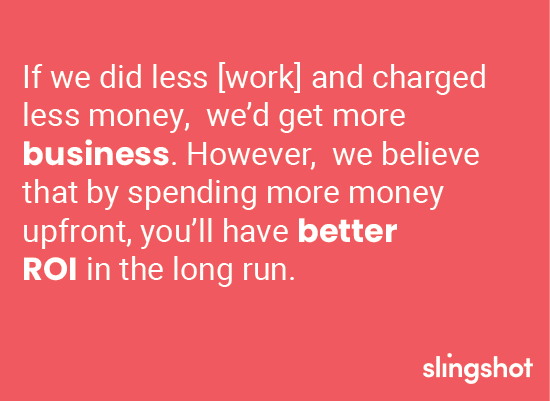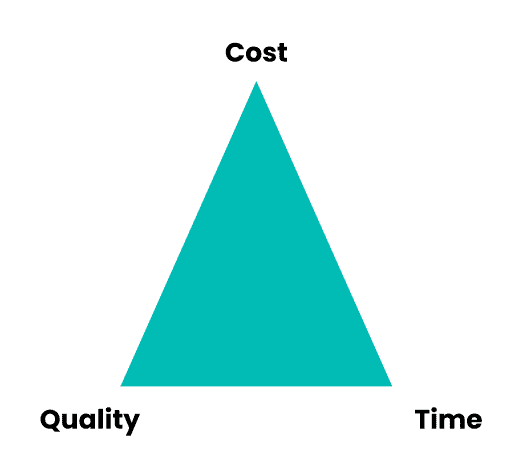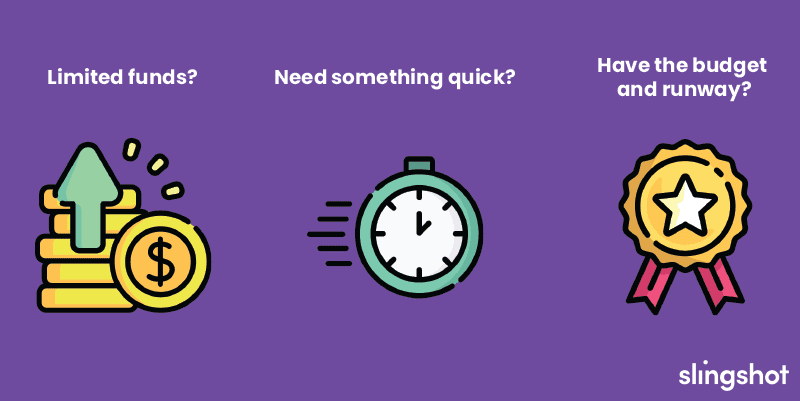When looking for a company to partner with, chances are you’re going to be getting proposals from several different firms. There are several factors that go into deciding which proposal you’ll choose. One of those is cost; you could be looking to choose the cheapest proposal.
But not so fast! You should be evaluating not just short term savings, but long term as well. And you can’t do this if you’re comparing apples and oranges, aka comparing proposals that don’t cover the same services.
That’s where this short and sweet guide comes in. While this guide covers development specifically, you can use this to compare ANY proposals that come your way.
Today, you’ll take a look at the average project cost breakdown vs our own (it’s the easiest example to pull from, of course ?). Through this exercise, you’ll learn why development proposals can vary so much, why ‘cheap’ doesn’t always equal ‘best deal’ in the long run, and how to choose what’s best for your organization.
Summary
Upfront costs can look drastically different depending on the companies and proposals you’ve collected. You should compare apple to apples, not apples to oranges; make sure that if a proposal offers more services, that the higher price tag doesn’t immediately turn you away.
We recommend spending some extra time and money upfront to ensure your product is built effectively the first go-round. If you don’t have time, you’ll have to give up cost or quality to get your product developed. If you’re low on cash, it’ll be between time or quality.
Project Costs – Average vs Slingshot
Imagine you’re a CTO who’s looking to outsource a project for your company. You’ve spoken to several different development firms, and have narrowed it down to two: Company A, and Slingshot. If we’re saying Company A is your average development firm, chances are this is what their proposal will include:
- A discovery phase; the cost for gathering requirements
- Meeting time, both between the client and the team
- Project management hours
- Development hours
- Infrastructure setup and deployment
It’s important to mention that there may be time budgeted for design or dedicated QA, but there usually isn’t. If this is the case, the project manager and developers will handle design and testing.
Related Article: How the Cost of Change in Development is Affected by Time
Now it’s comparison time. Slingshot offers all that’s above, but also includes:
- Initial discussions with stakeholders
- Studying competitors if applicable
- User Interviews and User Testing
- Design hours with an internal team to create wireframes, UI design, UX design, and prototypes
- Dedicated QA hours
While both of these projects will end with you having a product developed, you can see that they have different steps and phases. What does this mean for cost? Keep on reading!

Upfront Savings vs Long-Term ROI
As you can see, Company A has less upfront spend, meaning that you’ll get to market at a lower cost. And as we mentioned earlier, chances are you’ll go with the cheaper proposal.
Areas of Focus
So why doesn’t Slingshot do this? If we did less and charged less money, we’d get more business. However, we believe that by spending more money upfront, you’ll have better ROI in the long run. What areas do we recommend focusing on?
Users |
Design |
Testing |
Launch |
| By spending more time with users upfront, you can ensure that it’s built for them from the beginning. That means a successful problem-solving product at launch. | The design of a product is the first thing a user sees, and you only get one shot for first impression. Putting in time for design has a huge impact on the success of a product. | You’d rather have a developer find bugs than a user, right? By having dedicated personnel who focus on testing, you can lower the number of issues users experience. | Your product at launch is in its most vulnerable state; any changes from this point on will be extremely costly. By spending more upfront, you won’t have as many changes post launch. |
The Project Triangle
A visual comparison most people use when building a product is a triangle of Cost, Time, and Quality. It’s pretty impossible to have all three, so you need to choose two.

You can quickly build a quality product but it’s going to cost you. You can build something cheap and fast, but it will not be the best quality. By compromising on any of these areas, you’re ultimately affecting your ability to get the largest return on investment.
For us, we believe that quality is the most important, but that you lose opportunity cost the longer it takes to get to market. Process of elimination means that our products are built relatively fast and high quality, but we won’t be the cheapest proposal in the box.
De-risk
The last important aspect of upfront spend is de-risking your investment. Just like with donations or stocks, you want to work with a company that has put in the effort for success. If you spend some upfront money to build a more robust product, chances are you’re going to have a more successful one.
And while not 100%, this usually means a bigger ROI in the long run. If you have to report to stakeholders to get funding, they’ll have more confidence in you moving forward if that first product was a victory; Success at launch means getting additional funds down the road.
So to recap: by spending money upfront, you’ll have a more robust product that’s high quality and built relatively fast. That product will also be more likely to succeed thanks to the work you’ve done ahead of time. Sounds like a good choice, right? But this is where we hit the fork in the road: not everyone has the resources to spend the extra money up front…

So what’s the best option?
That’s the hard part: there isn’t one perfect answer. Your personal and company’s priorities should be the deciding factor when choosing a firm.
Limited funds? Go for the cheapest option. You may have to give up speed or quality, but you need to address your weakest link.
Need something quick? Find a shop that can build it fast. You’ll likely lose on quality (unless you’re spending a lot of money), but you will have something in the market sooner to start from.
Have the budget and runway to spend more? Build something that’s high quality. It’ll cost you time or cash right now, but you’ll thank us later.
Conclusion
A good metaphor to wrap this up is buying shoes: you can either buy cheap or nicer shoes. While it costs less to get lower-quality shoes, that quality difference leads to them wearing down a lot faster, meaning you’ll have to buy even more shoes over time. But if you spend a bit more upfront and get the nicer shoes, they’ll last a lot longer and you won’t have to replace them anytime soon.
So how do you save development dollars in the long run? You put in effort up front to ensure your product is successful at launch.
In the end, the best way to decide which firm to go with is to figure out what’s best for you and your business. We hope it’s Slingshot, but it might not be. And that’s okay – we still love you ❤️




